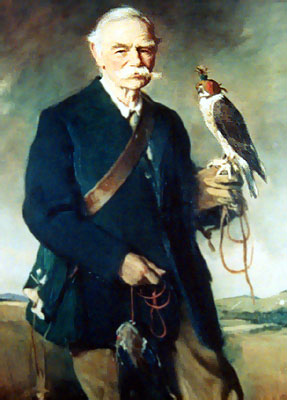 |
 |
|||
|
 George
Blackall Simonds George
Blackall Simonds(1843-1929) Born: 6th October 1843 at Reading, Berkshire Sculptor Died: 16th December 1929 at Bradfield, Berkshire George Simonds was the second son and fourth child of George Simonds Senior of Reading in Berkshire, director of the H & G Simonds Brewery in the same town, by his wife, Mary Anne Boulger. His grandfather was the great brewing and banking magnate, William Blackall Simonds. George became an early student at St Andrew’s College (later Bradfield College) in 1852. In 1858, aged just 15, he went to study sculpture under Professor Johannes Schilling in Dresden, moving on to study under Louis Jehotte at The Academy of Brussels, before living and working for 12 years in Rome from 1864. He returned to London in 1875 and set up his studio at 152 Buckingham Palace Road, moving on to Priory Studios, 21 North Bank in St John’s Wood in 1888. In 1877, he married Gertrude Prescott, an American whom he had met in Rome. They had a son George Prescott Simonds in 1881, who was killed in France at the beginning of World War I. George Simonds last exhibited in 1903 and his artistic life ended on the death of his elder brother Blackall in 1905, who in his Will, stipulated that George, as his heir, should take the Blackall name. He then became a Director of the prosperous family brewery in Reading, serving as Chairman from 1910 until his death in 1929. During this period he lived at ‘Rushall Grange’ in Bradfield, and ‘Holly Copse’ in Goring, all close to his mother’s ancestral home, Bradfield House, where he finally settled. George Simonds’ masterpiece ‘The Falconer’ has been made famous by the version which stands in Central Park in the city of New York. It depicts a young boy in 14th Century doublet, stepping forward and in the act of slipping a huge peregrine falcon. Simonds stays true to his idealist principles and continues the ‘Romantic’ theme of many of his works. The Central Park work (Opus 63) is mounted on a cylindrical granite pedestal perched on a natural outcrop of Manhatten Schist on 72nd Street, east of the Park’s West Drive. The statue itself, standing over 11 feet tall, was cast in a single piece using the ‘cire perdue’ or ‘lost-wax’ process by the master founder Professor Clement Papi (1802-1875) in Florence, Italy in 1870. While in Italy, Simonds learned much about the craft and traditions of lost-wax bronze casting. He later published an article on this subject in the journal ‘American Architect and Builder’ (Vol 19 15th May 1886, pp235-258), in which he argued for the use of lost-wax casting in Great Britain. The original life sized bronze
sculpture of the Falconer (Opus 51) was shown at the Vienna International
Exhibition of 1873. From here it was sent on for exhibition in Trieste,
Italy, where it was bought by ‘The Society of Arts’ and is now in the
‘Galleria d’arte Moderne del Civico Museo Revoltella’ a city museum. A
marble version with the falcon in ‘Electro Silver’ [Opus 88] was shown
at the Royal Academy Exhibition of 1875 and depicted in the Illustrated
London News of July 24th. George Kemp (1826-1893), a wealthy merchant born
in Ireland and who lived in New York City, admired the plaster form for the
original sculpture so much whilst on a visit to Rome in 1870 that he
commissioned a colossal bronze replica for Central Park without even waiting
to see the finished work. It was dedicated in New York on May 31st 1875.
Following international critical acclaim, three further small bronze
versions were later completed. Robert Evans, a Beverly native who had
admired the sculpture while convalescing in a hospital overlooking Central
Park, commissioned a bronze replica for Lynch Park, Beverly, Massachusetts.
A mould was taken from the original by local sculptor George Brewster. It
was then cast by Gorham Foundry, Newburyport using the lost-wax process in
about 1912. Simonds himself was an avid falconer. He became Founder President of the British Falconers’ Club in 1927 and was later depicted with a falcon in his official portrait as chairman of the family brewery, by Sir Oswald Birley RP (1880-1952). In 1884, with a group of young architects and artists inspired by John Ruskin (1819-1900) and William Morris (1834-1896) he founded and became the first Master of the Art Workers Guild in London. Their objective was to create a unified forum for architects, artists and craftsmen. Simonds said of the guild: “…it differs from all Art Societies in that it is not formed for the propagation of any one branch, or style, of art…. I find some things of the spirit of the Studio Life of Rome”. Other monumental works by
Simonds include the ‘Maiwand Lion’ sculpture he created in cast iron for
the Forbury Gardens in Reading, England in 1886. It was commissioned by the
Berkshire Memorial Fund with the Berkshire Regiment as a ‘Memorial to the
66th Regiment’, who had been almost wiped out in the Battle of Maiwand in
the Afghan War of 1880. In 1887, Simonds sculpted a monumental marble statue
of Queen Victoria for her Golden Jubilee, which stands outside Reading Town
Hall, and in 1891 a bronze portrait of industrialist, philanthropist and
biscuit king George Palmer for Broad Street, Reading, which was moved to the
local Palmer Park in 1930. Simonds created over 200 works in an
extraordinary diversity of media and techniques, mastering; marble, bronze,
plaster, terracotta, cameo, silver, brass, wood and cast iron, a remarkable
achievement.
|
|||
| © Raymond Simonds 2004. All Rights Reserved. | ||||





